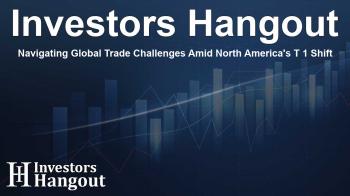Navigating Global Trade Challenges Amid North America's T+1 Shift

Introduction to Global Trade and T+1 Settlement
Recent analysis from Vermiculus and GreySpark Partners sheds light on the early impacts that the North American T+1 trade settlement mandate is having on international firms. This study highlights the significant adjustments needed as companies adapt to tighter timelines. The transition from a T+2 to T+1 settlement cycle introduces new dynamics in financial markets, prompting companies around the world to reevaluate their operational strategies.
Understanding the T+1 Settlement Model
The shift to a T+1 settlement model reduces the time allowed for post-trade processing, significantly tightening the timeline for transactions to settle. This advancement is designed to accelerate the trading process, but it also places immense pressure on financial institutions, especially those operating across various time zones. The necessity for efficient and speedy execution has never been greater.
Challenges Faced by Global Firms
As firms navigate these changes, several challenges emerge. Timing misalignments can lead to difficulties in trade execution, particularly for firms located outside North America. External factors such as foreign exchange (FX) execution add another layer of complexity; time constraints can lead to increased risk of transaction failure if not managed correctly. In addition, companies are grappling with staffing pressures, as existing resources may be stretched thin by the need for heightened operational capacity.
Insights from Industry Experts
Lars-Göran Larsson, an industry expert at Vermiculus, emphasizes the importance of automation in adaptation. "With the shift to T+1, especially across time zones, automated affirmation and allocation processes are no longer optional. Firms must act now to prepare for shorter settlement cycles propelled by global, 24/7 trading in the future," he states. This call to action emphasizes the need for investment in technology that enhances proactive risk management and aligns trade processing with new deadlines.
The Future of Trading Technology
The report underlines the expectation that real-time settlement and 24/7 trading capabilities will become standard in the near future. Firms must evolve their trading technologies to stay competitive, managing both digital and traditional assets adeptly. As these elements converge, organizations face mounting pressure to modernize their infrastructure to remain relevant in a fast-paced financial landscape.
Conclusion
The findings presented by Vermiculus and GreySpark Partners highlight the pressing need for firms to evolve in response to the T+1 settlement shift. Firms that embrace automation and invest in modern infrastructure stand to gain a significant competitive edge. Adapting to these changes will not only ensure compliance with new regulations but also enhance overall operational efficiency in an increasingly complex global market.
About Vermiculus Financial Technology
Vermiculus Financial Technology AB is at the forefront of providing innovative trading, clearing, and CSD solutions globally. Established in 2020, the company was founded by industry experts dedicated to revolutionizing exchanges and clearing technology. With its headquarters in Stockholm, the Vermiculus team boasts extensive experience, having successfully completed over 75 projects for top exchanges and clearing houses around the world.
Frequently Asked Questions
What is T+1 settlement and why is it important?
T+1 settlement refers to the trading cycle where the settlement of transactions must occur one day after the trade date. This is critical as it aims to reduce risk and improve the efficiency of trading processes.
How does the transition to T+1 affect global firms?
The transition affects global firms by requiring them to adjust their trading and back-office operations to accommodate tighter timelines, which can lead to increased operational pressures.
What challenges do firms face with T+1 implementations?
Firms face challenges such as timing misalignments across time zones, transaction execution pressures, staffing challenges, and the need for enhanced automation.
Why is automation emphasized in adapting to T+1?
Automation is crucial as it streamlines processes, reduces errors, and ensures compliance with the rapidly changing trading timelines that T+1 introduces.
What does the future hold for trading technology?
The future of trading technology leans toward real-time settlement and 24/7 trading capabilities, necessitating firms to modernize their infrastructures to stay competitive.
About The Author
Contact Henry Turner privately here. Or send an email with ATTN: Henry Turner as the subject to contact@investorshangout.com.
About Investors Hangout
Investors Hangout is a leading online stock forum for financial discussion and learning, offering a wide range of free tools and resources. It draws in traders of all levels, who exchange market knowledge, investigate trading tactics, and keep an eye on industry developments in real time. Featuring financial articles, stock message boards, quotes, charts, company profiles, and live news updates. Through cooperative learning and a wealth of informational resources, it helps users from novices creating their first portfolios to experts honing their techniques. Join Investors Hangout today: https://investorshangout.com/
The content of this article is based on factual, publicly available information and does not represent legal, financial, or investment advice. Investors Hangout does not offer financial advice, and the author is not a licensed financial advisor. Consult a qualified advisor before making any financial or investment decisions based on this article. This article should not be considered advice to purchase, sell, or hold any securities or other investments. If any of the material provided here is inaccurate, please contact us for corrections.

